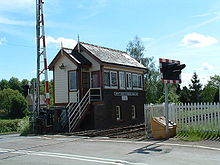
Ascott-under-Wychwood railway station
Encyclopedia
Ascott-under-Wychwood railway station is a railway station serving the village of Ascott-under-Wychwood
in Oxfordshire
, England
. It is on the Cotswold Line
. The station, and all trains serving it, are operated by First Great Western
.
To the west of the station is a level crossing, controlled by Ascott-under-Wychwood Signal Box, which also oversees the adjacent end of the double-tracked section of the Cotswold Line. Under proposals to extend the doubling of the route, the signal box was to be removed but budgetary constraints on resignalling led to that proposal being revised.

, it became part of the West Midland Railway and then was absorbed by the Great Western Railway
. The station then passed on to the Western Region of British Railways
on nationalisation in 1948.
The Reshaping of British Railways
report proposed the closure of Ascott-under-Wychwood station, but the recommendation was not implemented.
When Sectorisation
was introduced in the 1980s, the station was served by Network SouthEast
until the Privatisation of British Rail
ways.
Ascott-under-Wychwood
Ascott-under-Wychwood is a village and civil parish in the Evenlode valley about south of Chipping Norton, Oxfordshire.-History:The village is one of several named after the historic forest of Wychwood; the others being Shipton-under-Wychwood and Milton-under-Wychwood.Ascot d'Oilly Castle was...
in Oxfordshire
Oxfordshire
Oxfordshire is a county in the South East region of England, bordering on Warwickshire and Northamptonshire , Buckinghamshire , Berkshire , Wiltshire and Gloucestershire ....
, England
England
England is a country that is part of the United Kingdom. It shares land borders with Scotland to the north and Wales to the west; the Irish Sea is to the north west, the Celtic Sea to the south west, with the North Sea to the east and the English Channel to the south separating it from continental...
. It is on the Cotswold Line
Cotswold Line
The Cotswold Line is an railway line between and in England.-Route:The line comprises all or part of the following Network Rail routes:*GW 200 from Oxford*GW 310 from Wolvercot Junction*GW 300 from Norton Junction*GW 340 from Worcester Shrub Hill...
. The station, and all trains serving it, are operated by First Great Western
First Great Western
First Great Western is the operating name of First Greater Western Ltd, a British train operating company owned by FirstGroup that serves Greater London, the South East, South West and West Midlands regions of England, and South Wales....
.
To the west of the station is a level crossing, controlled by Ascott-under-Wychwood Signal Box, which also oversees the adjacent end of the double-tracked section of the Cotswold Line. Under proposals to extend the doubling of the route, the signal box was to be removed but budgetary constraints on resignalling led to that proposal being revised.

History
Opened by the Oxford, Worcester and Wolverhampton RailwayOxford, Worcester and Wolverhampton Railway
The Oxford, Worcester and Wolverhampton railway was a company authorised on 4 August 1845 to construct a railway line from the Oxford and Rugby Railway at Wolvercot Junction to Worcester, Stourbridge, Dudley, and Wolverhampton, with a branch to the Grand Junction Railway at Bushbury...
, it became part of the West Midland Railway and then was absorbed by the Great Western Railway
Great Western Railway
The Great Western Railway was a British railway company that linked London with the south-west and west of England and most of Wales. It was founded in 1833, received its enabling Act of Parliament in 1835 and ran its first trains in 1838...
. The station then passed on to the Western Region of British Railways
Western Region of British Railways
The Western Region was a region of British Railways from 1948. The region ceased to be an operating unit in its own right in the 1980s and was wound up at the end of 1992...
on nationalisation in 1948.
The Reshaping of British Railways
Beeching Axe
The Beeching Axe or the Beeching Cuts are informal names for the British Government's attempt in the 1960s to reduce the cost of running British Railways, the nationalised railway system in the United Kingdom. The name is that of the main author of The Reshaping of British Railways, Dr Richard...
report proposed the closure of Ascott-under-Wychwood station, but the recommendation was not implemented.
When Sectorisation
British Rail brand names
British Rail was the brand image of the nationalised railway owner and operator in Great Britain, the British Railways Board, used from 1965 until its breakup and sell-off from 1993 onwards....
was introduced in the 1980s, the station was served by Network SouthEast
Network SouthEast
Network SouthEast was one of three passenger sectors of British Rail created in 1982. NSE principally operated commuter trains in the London area and inter-urban services in densely populated South East England, although the network reached as far west as Exeter...
until the Privatisation of British Rail
Privatisation of British Rail
The privatisation of British Rail was set in motion when the Conservative government enacted, on 19 January 1993, the British Coal and British Rail Act 1993 . This enabled the relevant Secretary of State to issue directions to the relevant Board...
ways.

